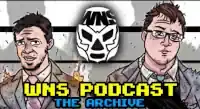WNS Column: Wilds' War Cry - Badass to Big Evil
Posted By: Stephen Wilds on Aug 02, 2017One of wrestling’s greats went through quite the interesting mid-career crisis when he traded in the coffin for a chopper and his robes of darkness turned into a shirt that boasted the corny moniker of “Big Evil.” The man who is rarely referred to as Mark Calaway put a lot of work in as a company man and turned what sounded like a horrible gimmick on paper into gold as The Undertaker, so when it came time to mix things up a little and tweak the character, it was something he had earned, but not everyone felt it was a wise decision. Now with his epic career seemingly at an end, aside from a few key events, this time period may be remembered as the most controversial part of an otherwise legendary journey. Looking back over this part of history though, it’s time to try and figure out what worked, what didn’t, and maybe see the reasons, or just who to blame.
So, for those who may have forgotten or just never saw it, let’s talk about the period of 2000-2003 where The Deadman showed how he was a true American Badass. I remember reading a book when I was much younger, before this ever happened, that depicted the epitome of death as a rough-and-tumble biker drenched in chains and leather, hardened by his irreverent attitude and cold demeanor. Years later I would see that brought to life in this new character, dealing out death sentences in a wrestling ring. That was the impression I got upon first seeing him at the Judgment Day PPV in May of that year, with a bit of excitement as to the Phenom’s future, and what this meant for the locker room. What others saw as he interrupted HHH and The Rock though was a lack of logic in his motivation and a few extra pounds around his waist. This was due to him being called back early, as he was originally promised more time to recover from an injury. There were hints of this look seem as far back as 1998 though, where Taker rocked the bandana and copped the attitude, but now he was attempting to embody those traits.
Coming out to Kid Rock’s “American Badass” fit the gimmick and supposedly lent to the name, but some viewers felt that this new approach was still stuck in the early part of the Attitude Era, attempting to capture a tone that was no longer as prevalent. It looked like an aging wrestler still trying to throw his weight around in what he called, ‘his yard,’ while wanting to ride his motorcycle more, instead of it amplifying the gimmick. There were some somewhat humorous issues with that thing too. While many fans felt Undertaker needed something new around this time, this fresh personal may have been more than they bargained for. This was someone closer to Mark, his natural persona ramped up, trying to build more character by accentuating his natural qualities, similar to what many said put Stone Cold over.
The change on the character involved depowering him in a lot of ways, which again some didn’t like, but it led to him seeming more human and in some small ways helped with the face persona, which seemed to be the initial focus. Introducing his current wife, Sara, also made the former dark lord seem more mortal, but in a bad way, as she became over exposed. I remember a friend complaining a lot about her calling him Mark on camera. This also led to a horrible plotline with Diamond Dallas Paige, and both of those wrestlers, not to mention the audience, deserved so much better and it might have been the lowest point of the ABA run.
“Are you the next big thing, or the next big bitch?”
The gimmick brought about some cool things like the Brothers of Destruction, the ladder match with Jeff Hardy, and some fierce quotable one-liners, but it was all in brief doses, and some believe their hero still owed them more for almost making many fans like a Limp Bizkit song. The things that are brought up most though when people talk about what didn’t work are parts that many thought The Deadman would never have trouble with. His ring work being one of the most evident examples, as he attempted to change his style and began to move differently, causing many in the audience to lose interest in the physicality of his matches, focusing more on strikes, more brutal beat downs, and what some saw as unearned victories. His promos should have complimented the in-ring work and helped fill in some of the gaps that were caused by changing things up, but they fell short often and caused the opposite reaction on a few occasions. Undertaker was going to have the chance to talk more now, from the heart as it were, and that came with a few positives, but a couple of more noticeable negatives after his years of ominous edicts that helped to hide any flaws as an orator early in his career.
In some ways it looked like many of the smaller bad decisions that began adding up may have come from Undertaker himself, as this is rumored to be when he began exercising more creative control and insisting on certain things being added, though he was still always a company man and willing to put others over or attempt to make them look good at least when the company asked. It isn’t hard to guess from all of the reports that Taker was in need of a change himself, not just for the character. If Kevin Nash is to be believed in his interview with Extra Mustard, Undertaker was considering jumping ship at one point, and was most likely given everything he wanted—like a more prominent role for his wife—and perhaps this was what he needed to recharge his desire to be one of the core guys in the company.
“We had ‘Taker close. All of a sudden he wasn’t the Deadman. He became the American Badass for a reason. That Deadman wasn’t going to f—in’ come to WCW. He would have been the biker character and gone by Mark Calaway. All Along, I was trying to get guys money, I was trying to get guys paid. And what happened was Vince started giving huge guaranteesto the Shawns and Undertakers and those guys and said, ‘I can’t lose my core guys.’”
WWE seems to want everyone to forget this part of his career if possible. I guess I can understand not wanting to focus on Undertaker making Tommy Dreamer drink his tobacco spit, or turning heel by making Jim Ross kiss Mr. McMahon’s ass, but why ignore entire matches from the history, like his slobber-knocker against HHH at Wrestlemania 17. This is something no one should bring up in front of Vince either, as a few stories claim that he does not react well to the gimmick being mentioned, whether that is because Vince didn’t have a hand in crafting that persona or he just wants fans to forget it so the Undertaker’s mystique stays intact, it seems silly to simply ignore it, and might be one of my biggest problems with the whole thing personally.
“I may not dress like Satan anymore, but I’m still down with the devil.”
This is a gimmick that is much easier to criticize upon reflection, but many still point out the good, even if the bad makes for a funnier conversation. No one would claim that the biker gimmick came close to the levels of The Deadman, or even any other part of his career, even those who first saw him in that incarnation. People who grew up on the ABA still view that as an off time and I personally don’t think this type of gimmick would have been granted without his previous runs—though Baron Corbin’s existence may prove me wrong—the favor he had garnered from the fans. What it did accomplish was allowing Mark Calaway some needed flex room or possibly a recharge and hopefully refined some of his future decisions with the character. Fans were excited to see his return to form at Wrestlemania XX, no matter the match, it was as if an old friend returned after a rough time. I think this period was a needed phase with some good parts, but it’ll always be seen as the weakest chapter in an otherwise great book.
Follow me on Twitter: @StephenWilds
⚡ Explore WNS
Jump To Comments

Popular Tags
Popular Articles

Become WNS Member

Member Login

Edit Profile

Blocked Users

LeaderBoard

Donate to WNS

Logoff


📣 WNS Member Discussion
⚡ Events
Dark Side of the Ring Season 6 Episode 5 - Billy Jack Haynes
N/A
May 6th, 2025 at 8:00 PM
Airing on Vice TV



















Leave a Comment ()